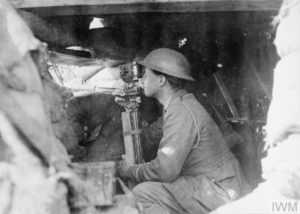Tuesday February 26th, 1918
Too done up for writing. Only could do with bigger rations.
Observation Posts

Poor Frank is tired and hungry today and, while never a prolific diarist, has all but dried up.
When I read the Battalion diary today, I was a little confused about what was going on. Eventually I realized that the red and white lights were Johnny’s and the artillery bombardment was Tommy’s. Which just goes to show how dangerous those flares could be if spotted by the wrong side. The photograph shows an Artillery Officer in a front line observation post – presumably similar to the one that spotted the flares.*
The bombardment to the north east of Lake Dojran would be in the Krusha Balkans. Snevce was to the south east of Lake Dojran and was the terminus of the light rail line from Sarigol.
The Independent Brigade
I haven’t been able to find out much about the reference to the ‘Independent Brigade’ beyond a sentence in ‘Under the Devil’s Eye’ when describing the terrain in the Krusha Balkan hills. With the enemy in the mountains, no-man’s land extended to several miles across a valley. Apart from the very front lines, neither side was reachable even by the artillery. ‘Except when a raid on some enemy position was in progress there was little war.’¹. The authors continued, ‘Broken terrain allowed the hills to be held by an ‘Independent Brigade’ detached from its parent formation.‘¹ This seems to be applying ‘infiltration tactics’ where attempts are made by smaller groups to get into stronger attack positions by using stealth.
This British line in the Krusha Balkan hills, because of its relative quietness, was sometimes manned by soldiers unfit for more demanding combat duty. The 228 Brigade, made up of four garrison battalions, was an example of this. Soldiers in these battalions would have been medically classified ‘B’. As noted by Major Christopher Hughes when posted to the 228th, ‘Physically the brigade was in a terrible state. They were splendid crocks…some were almost blind, some almost deaf, and the 22nd Rifle Brigade had more than sixty men over sixty years old.’²
Other units that served on this front included ones that had suffered heavy casualties and needed time to regroup. The 79th Brigade just after the First Battle of Dojran would have fallen into this category. Of almost 3,200 British casualties in one assault in April 1917 ,over 75% of them had been suffered by the 79th. This would have been at least half of their effective strength.
Any insight to the ‘Independent Brigade’ will be gratefully received!
13th (Service) Battalion War Diary – 26th February 1918 – No 1 Sector, Minden Camp
At 06:00 hrs in response to a signal of Red and White lights an artillery bombardment north east of Lake Dojran commenced and continued until 07:00 hrs. Most probably the Independent Brigade (79th Brigade, 26th Division) in the Snevce area was carrying out a raid. Our artillery was fairly quiet all day. Enemy artillery fired all over the sector all day, mostly light air burst and shrapnel. Three of our planes flew over enemy lines about 08:30 hrs, probably a bombing raid. Enemy aircraft inactive. A patrol which proceeded up Patty Ravine saw and heard nothing of the enemy, but found a rifle and bayonet and, under two skeletons, also a pick. The rifle, bayonet and pick were brought in. Movement was seen through the loophole of the observation post at the eastern end of O1. Capt GT Newman left for base 25-2-18 to await embarkation for leave to UK. 1 OR having been wounded in action is struck off from 25-2-18. 4 OR are struck off under GRO 1011 with effect from 25-2-18.
References & Further Reading
¹ Lt MJ Rattray ‘Further Recollections’ quoted in ‘Under the Devil’s Eye’. (Kindle Location 3262)
² ‘Under the Devil’s Eye’ by A Wakefield and S Moody (Kindle Location 3275)
‘Infiltration tactics‘, Wikipedia
* ‘Observation Post‘, Imperial War Museum


